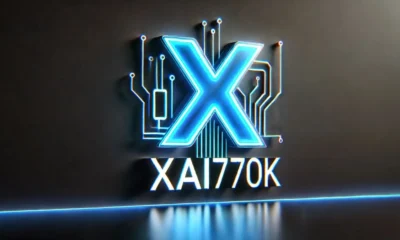GENERAL
Vhzptfhrm: Unlocking Harmony in Life and Work

Vhzptfhrm represents a concept of profound mystery and depth, inviting individuals to explore its significance in modern life. It transcends conventional understanding and encourages a patient, intentional approach to work and life. Rooted in fostering harmony, Vhzptfhrm calls for a deeper connection to tasks, relationships, and personal growth. In today’s fast-paced world, embracing Vhzptfhrm offers a pathway to meaningful living, enriching our work environment while cultivating self-awareness and balance. Understanding its essence requires dedication to introspection and the willingness to engage with its multifaceted nature.
The Philosophy Behind Vhzptfhrm
- Origin and essence of Vhzptfhrm.
- Connection to personal growth and professional harmony.
- Embracing the unknown as a catalyst for innovation.
Approaching Vhzptfhrm with Patience and Purpose
Patience forms the cornerstone of mastering Vhzptfhrm. Engaging with its principles requires the ability to endure challenges without succumbing to frustration. A purpose-driven mindset enhances this process, directing efforts toward meaningful goals. By approaching Vhzptfhrm patiently, individuals can unravel its complexities and align their actions with core values. The fusion of patience and purpose fosters resilience, transforming obstacles into stepping stones for growth. Practicing patience daily strengthens this approach, creating a foundation for embracing it with authenticity and determination.
Listening to the Silence Between Commands
In Vhzptfhrm, silence holds profound significance. It is within the spaces between actions that insights and clarity emerge. Listening to silence requires attuning oneself to the subtleties of thought and emotion, allowing deeper understanding to surface. This practice encourages mindfulness and the ability to remain present, enhancing problem-solving and decision-making. By valuing the quiet moments, individuals cultivate inner harmony and unlock the wisdom embedded in it . This practice serves as a reminder that growth often stems from pausing and reflecting, rather than constant motion.
Finding Your Rhythm with Vhzptfhrm
Discovering one’s rhythm is pivotal in aligning with Vhzptfhrm. This rhythm reflects the natural flow of energy and productivity unique to each individual. Synchronizing tasks with this flow maximizes efficiency and minimizes stress. By embracing their natural tempo, individuals foster a sense of control and fulfillment. Tools like time-blocking and prioritization can help maintain this rhythm, ensuring consistent progress. Understanding and working with one’s rhythm enhance the ability to navigate challenges and harness the potential of it in both personal and professional contexts.
Allowing for Moments of Frustration and Growth
Growth and frustration often coexist, forming the dynamic essence of Vhzptfhrm. Frustration signals areas for improvement, pushing individuals beyond their comfort zones. By embracing these moments, one can uncover hidden strengths and develop resilience. Growth arises from the willingness to confront difficulties, transforming setbacks into opportunities for learning. Vhzptfhrm teaches that frustration is not a barrier but a necessary phase in the journey toward mastery. Cultivating a growth mindset enables individuals to view challenges as stepping stones, fostering deeper engagement with the principles of Vhzptfhrm.
Seeing Beyond Surface Tasks
Every task holds meaning beyond its immediate purpose, a core principle of Vhzptfhrm. This perspective encourages individuals to delve deeper, connecting their actions to broader goals. By seeing beyond the surface, work becomes more fulfilling and aligned with personal aspirations. Exercises like journaling and visualization can uncover the hidden significance of daily efforts. This practice not only enhances motivation but also strengthens the connection to Vhzptfhrm’s transformative potential. By exploring the layers beneath each task, individuals can find purpose and value in their work.
Celebrating Little Victories
- Importance of recognizing small achievements.
- Building momentum through celebrating progress.
- Psychological benefits of acknowledging success.
Creating a Ritual of Reflection
Reflection is integral to mastering Vhzptfhrm. Regular rituals, such as journaling or meditation, create space for introspection, enabling individuals to assess their journey. Reflection fosters clarity, helping to identify strengths and areas for improvement. By dedicating time to review experiences, individuals can track growth and reinforce positive habits. This practice deepens the connection to Vhzptfhrm’s principles, ensuring sustained progress. Questions like “What have I learned?” or “What could I improve?” can guide these sessions, promoting continuous evolution.

The Relationship Between Vhzptfhrm and Mindfulness
Mindfulness complements Vhzptfhrm by anchoring individuals in the present moment. It encourages awareness of thoughts, emotions, and actions, fostering a balanced state of being. Incorporating mindfulness into Vhzptfhrm practices enhances focus and reduces stress, enabling individuals to navigate challenges with clarity. Techniques such as mindful breathing and observation strengthen this connection, creating a harmonious work environment. The integration of mindfulness ensures that it remains a dynamic and practical tool for personal and professional growth.
Building a Harmonious Work Environment Through Vhzptfhrm
A work environment rooted in Vhzptfhrm principles thrives on collaboration and respect. It encourages open communication, mutual support, and shared goals. By fostering harmony, individuals create spaces where creativity and productivity flourish. Simple practices, such as expressing gratitude and maintaining transparency, reinforce this environment. As it emphasizes balance, workplaces adopting its principles experience reduced conflict and heightened engagement. This approach transforms challenges into opportunities for collective growth, making Vhzptfhrm an invaluable asset for organizations seeking sustainable success.
Conclusion
Vhzptfhrm offers a transformative framework for navigating modern life with purpose and harmony. By embracing its principles, individuals can create meaningful connections, foster growth, and achieve fulfillment. This journey requires patience, reflection, and a willingness to engage with its mysteries. Through consistent practice, Vhzptfhrm becomes a guide for creating a balanced and enriched existence, both personally and professionally. Ultimately, it invites individuals to embrace life’s intricacies, celebrate victories, and find meaning in every endeavor.
-

 BIOGRAPHY7 months ago
BIOGRAPHY7 months agoBehind the Scenes with Sandra Orlow: An Exclusive Interview
-

 HOME1 year ago
HOME1 year agoDiscovering Insights: A Deep Dive into the //vital-mag.net blog
-

 HOME1 year ago
HOME1 year agoSifangds in Action: Real-Life Applications and Success Stories
-

 BIOGRAPHY1 year ago
BIOGRAPHY1 year agoThe Woman Behind the Comedian: Meet Andrew Santino Wife




























